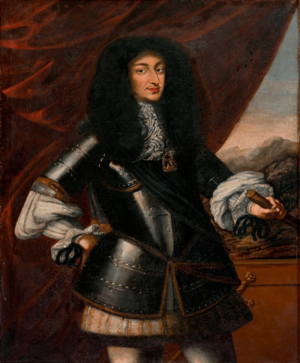Charles Emmanuel II, Duke of Savoy facts for kids
Quick facts for kids Charles Emmanuel II |
|||||
|---|---|---|---|---|---|
 |
|||||
| Duke of Savoy | |||||
| Reign | 4 October 1638 – 12 June 1675 | ||||
| Predecessor | Francis Hyacinth | ||||
| Successor | Victor Amadeus II | ||||
| Regent | Christine of France (1638–1648) | ||||
| Born | 20 June 1634 Turin, Savoy |
||||
| Died | 12 June 1675 (aged 40) Turin, Savoy |
||||
| Burial | Turin Cathedral | ||||
| Spouse | Françoise Madeleine d'Orléans Marie Jeanne of Savoy |
||||
| Issue | Victor Amadeus II of Savoy | ||||
|
|||||
| House | Savoy | ||||
| Father | Victor Amadeus I, Duke of Savoy | ||||
| Mother | Christine of France | ||||
| Religion | Roman Catholicism | ||||
Charles Emmanuel II (Italian: Carlo Emanuele II di Savoia) was born on June 20, 1634, and died on June 12, 1675. He was the Duke of Savoy from 1638 until his death. For the first ten years of his rule, his mother, Christine of France, acted as his regent. He also held titles like Marquis of Saluzzo and Count of Nice. When he passed away in 1675, his second wife, Marie Jeanne Baptiste of Savoy-Nemours, became the regent for their nine-year-old son, Victor Amadeus II.
Contents
About Charles Emmanuel II
His Early Life and Becoming Duke
Charles Emmanuel II was born in Turin, which was part of the Duchy of Savoy. His parents were Victor Amadeus I, Duke of Savoy, and Christine of France. His mother was the daughter of Henry IV of France.
In 1638, when Charles Emmanuel was only four years old, his older brother, Francis Hyacinth, Duke of Savoy, passed away. This meant that Charles Emmanuel became the new Duke of Savoy. Because he was so young, his mother, Christine, governed the Duchy for him. Even after he became an adult in 1648, he asked her to continue helping him rule.
Challenges During His Rule
Charles Emmanuel faced some difficulties during his time as Duke. He was known for conflicts with a group of people called the Vaudois, also known as Waldensians. These conflicts became very serious in 1655 and were known as the Piedmontese Easter.
The events were so difficult that they caught the attention of other countries. The English poet John Milton wrote a poem about it. Oliver Cromwell, who was the leader in England at the time, even offered to send the British Navy to help stop the fighting. He also raised money to support the Waldensians.
Taking Full Power and Making Changes
Charles Emmanuel truly took full control of the Duchy after his mother died in 1663. He tried to gain access to the sea by fighting against Genoa in the Second Genoese–Savoyard War (1672–1673), but he was not successful. He also had to work hard to keep his Duchy independent from the powerful country of France, which was a close neighbor.
Despite these challenges, he made many positive changes for Savoy.
- He greatly improved trade and wealth in the Duchy.
- He developed the port of Nice.
- He built a new road through the Alps to France, which helped with travel and trade.
- He also reformed the army. Before, the army was mostly made up of soldiers from other countries. Charles Emmanuel created five new regiments made up of soldiers from Piedmont, a region in Savoy.
- He also brought back cavalry (soldiers on horseback) and introduced uniforms for the army.
- He worked to restore and strengthen the Duchy's forts and defenses.
- He also built many beautiful buildings in Turin, including the Palazzo Reale.
Charles Emmanuel II died on June 12, 1675. He was buried at Turin Cathedral.
Marriages and Family
Charles Emmanuel II was married twice.
His first marriage was to Françoise Madeleine d'Orléans on April 3, 1663. She was his cousin, as her father was his mother's younger brother. They did not have any children together. His mother died at the end of 1663, and his first wife passed away at the beginning of 1664.
After his first wife's death, Charles Emmanuel was free to marry again. On May 20, 1665, he married Marie Jeanne of Savoy. They had one son:
- Victor Amadeus II of Savoy, who later became King of Sicily and then King of Sardinia. He married Anne Marie d'Orléans and had children.
See also
 In Spanish: Carlos Manuel II de Saboya para niños
In Spanish: Carlos Manuel II de Saboya para niños


